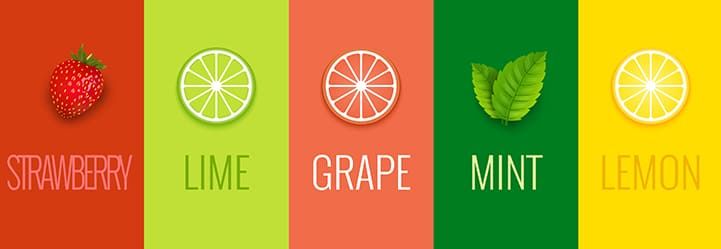Fruit flavors: which are the leading players in the food industry?
There is no doubt that their natural variety is one of the reasons why fruit flavors are so popular in the food industry. We see them across product categories - from dairy to confectionery to baked goods, beverages and baby food. Read on to discover more about the fruit flavors dominating current food production trends.
Essential guide to fruits
When we talk about fruits, we usually imagine juicy, succulent products with a sweet or sour taste. Technically speaking, a fruit is the fleshy or dry ripened ovary of a flowering plant that encloses seeds. Thus, tomatoes are consider as much a fruit as bananas and peaches, for example (Editors of Encyclopedia Britannica, 2024).
There are two general categories of fruit (Editors of Encyclopedia Britannica, 2024):
- Dried, such as legumes, cereals, nuts and capsulated fruits (such as cotton and poppy).
- Fleshy, such as berries, aggregate fruits (e.g., blackberries, strawberries and raspberries) and multiple fruits (such as figs and pineapples).
In turn, fleshy ones are divided into other categories according to their structure (Editors of Encyclopedia Britannica, 2024):
- Drupe, such as plum, peach, cherry and coconut. They are characterized by their juicy flesh and sweet or sour taste.
- Berries, such as grapes, tomatoes, blackberries, blueberries, and strawberries. They are fleshy, soft and have juicy pulp.
- Pepo, such as watermelon, pumpkin, and cucumber. Their pulp has a high-water content, so they are very refreshing.
- Hesperidium, such as orange, lemon, tangerine, and grapefruit. They are particularly juicy, with flavors that combine sweet and sour.
- Pome, like apple and pear. They are fleshy and sweet fruits.
On the other hand, consumers tend to classify fruits according to their growing cycle. Depending on their location, some markets have seasonal fruits. Likewise, location also determines that certain fruits are considered out of the ordinary in specific markets. For example, some tropical fruits are now common thanks to international trade, such as mangoes and bananas. Others remain exotic, such as mangosteen and tamarind.
The use of fruits in food production
Fruits are not only a well-known product in their own right. They also excel as natural ingredients in food processing. Manufacturers use them in a variety of ways. The best known is as a source of flavor and nutritional content. But there are other applications as well. For example, fruits can be natural preservatives, as they contain bioactive compounds and offer antioxidant and antimicrobial activity (Munekata, et al., 2023).
Puree is one of the most widely used fruit types in the food industry. This is because it offers multiple benefits for producers (Grand View Research, 2023; Persistence Market Research, 2023):
- Acts as a natural sweetener and flavor.
- Improves texture and color of final products.
- It has high nutritional value.
- Its power as a preservative contributes to a longer shelf life of the final products.
- It is a favorable input from the logistic point of view. It is easier to transport and store than fresh fruit.
Additionally, the use of fruit puree for food processing at the industrial level responds to today's key consumer trends. Consumer interest in foods perceived as healthy is on the rise. Here, natural and nutritious ingredients are key (Grand View Research, 2023).
Thus, fruit puree is profusely used in the production of dairy, confectionery, baked goods, baby food, beverages, desserts, drinks and sauces (Grand View Research, 2023).
However, fruit flavors are prominent in consumer preferences. They appear in virtually every category of the food industry. They are attractive in desserts, dairy products and snacks. The same is true in the field of alcoholic, non-alcoholic and sports drinks (T. Hasegawa, 2022).
So, what are the fruit flavors that master food production?
The most popular fruit flavors in the food industry
These are the ones that have remained at the top in recent years (FONA International, 2021; Mc Flavor Solutions, 2023 and 2024):
Classic fruit flavors
Some flavors never go out of style. Some that last include:
- Cranberries, in baked goods, snacks and dairy products.
- Cranberries, in juices and baked goods.
- Cherry, in desserts, ice cream, confectionery, and snacks.
- Lemon, in confectionery, juices and flavored water.
- Orange, in juices, baked goods and confectionery.
- Peach, in snacks, baked goods, spreads, teas, desserts, and confectionery.
- Strawberry, in dairy products, desserts, ice cream and confectionery.
The latter is a traditional flavor, widely known and preferred by consumers of all ages. Even so, it continues to play a leading role in new products in various categories. By 2022, there were more than 20 thousand strawberry food launches worldwide in the categories of desserts and ice cream, confectionery, baked goods, dairy, juices, and snacks (Mc Flavor Solutions, 2023).
Exotic fruit flavors
Consumers' thirst for adventure is also a factor in their popularity. As a result, tropical and exotic fruit flavors are also attractive for food processing. Leading examples include passion fruit, pineapple, guava, and banana.
Lychee, on the other hand, is a top exotic flavor in the beverage category. It has been featured in multiple recent alcoholic, non-alcoholic and sports beverage launches. It has also been an ingredient in new confectionery, baked goods, dairy, and desserts (Mc Flavor Solutions, 2024).
Moreover, the marked interest in global flavors has opened the way for some such as tamarind. The sweet and tart character of this fruit has deep roots in international cuisine, and today it is making its way into products like yogurts, juices, and sauces. The same happens with pitaya, also known as dragon fruit. This flavor has been dominating the categories of energy drinks, iced tea and nutritional beverages.
Innovation in fruit flavors
Food producers need to stay at the forefront to meet consumer expectations. In the case of fruit flavors, blends are positioned as successful formulas to generate interest. A 2023 analysis by Mc Flavor Solutions indicates that consumers gravitate toward blends like strawberry lemonade, fruit punch, peach and mango, mango and guava, and strawberry and pitaya.
Other experts believe that blends are also useful for following seasonal consumption trends. For example, there are blends that satisfy palates during spring and summer. This is the case of strawberry and kiwi, pineapple and mango, and guava and carambolo (Rusinko, 2024).
The possibilities for combining fruit flavors are almost endless. The most popular ones have others that complement their profile and can be successfully applied in food production (FONA International, 2021):
- Peach with mango.
- Blueberry with apple or lemon.
- Cherry with lemon.
- Guava with strawberry.
- Lychee with pineapple or coconut.
- Strawberry with banana.
There is no doubt that fruit flavors are incredibly versatile. These factors, along with their nutritional content, make them ingredients with undeniable potential to attract consumers in the food industry. Alimentos SAS is the best ally for using inputs to create high-level products.
Bibliographic References
- Editors of Encyclopedia Britannica. 2024). Fruit. Encyclopedia Britannica.
- FONA International. (2021). TRENDING FRUIT FLAVORS 2021 & BEYOND.
- Grand View Research. (2023). U.S. Fruit Puree Market Size, Share & Trends Analysis Report By Product (Apple, Mango, Banana, Strawberry, Plum, Pear, Peaches, Mix), By Application (Beverages, Bakery, Snacks, Baby Foods), And Segment Forecasts, 2023 – 2030.
- Mc Flavor Solutions. (2023). Flavor combinations.
- Mc Flavor Solutions. (2023). Strawberry.
- Mc Flavor Solutions. (2024). Peach.
- Mc Flavor Solutions. (2024). Tamarind.
- Mc Flavor Solutions. (2024). TROPICAL FLAVOR ESCAPES.
- Munekata, P. E. S., Pateiro, M., Domínguez, R., Nieto, G., Kumar, M., Dhama, K., & Lorenzo, J. M. (2023). Bioactive Compounds from Fruits as Preservatives. Foods (Basel, Switzerland), 12(2), 343.
- Persistence Market Research. (2023). Fruit puree market.
- Rusinko, R. (2024). With Spring in the Air, Nostalgic Flavors Ready to Take Hold this Summer. VitaQuest.
- T. Hasegawa. (2022). Food and Beverage Flavor Trends Report.














